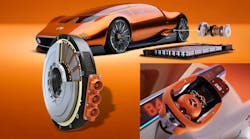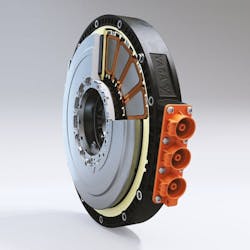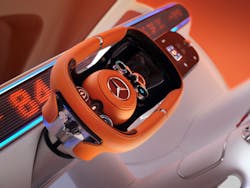Concept Car Features Axial-Flux Motor, “Unique” Battery Chemistry
I’m loath to engage in hyper-Ecar histrionics, but the two-seat electric-powered Mercedes-Benz One-Eleven concept vehicle revealed at the company’s Carlsbad design studio in Southern California is absolutely mind-boggling.
This gullwing-door sports car updates M-B’s wedge-shaped C111 experimental prototypes, of which 16 examples were produced over two generations during the late 1960s and early 1970s (Fig. 1). C 111 experimental vehicles were used to test Wankel rotary and early turbodiesel engines.
For motors used in EV drive systems, the requirements are a large torque output in the low-speed area and a wide constant-power speed range in the high-speed regime.
Yokeless Axial-Flux Motor
The One-Eleven’s technical highlights include a rear axle-mounted axial-flux motor developed by electric motor specialist YASA. The British company, based in Oxford, has been a 100% subsidiary of Mercedes-Benz AG since July 2021. The yokeless and segmented armature design of the electric motor also lent YASA its name (Yokeless—it has no stator yoke—And Segmented Armature).
YASA says the weight of the axial-flux electric motor is just one-third of that of the radial-flux electric motors Mercedes uses in its various batter electric vehicles (BEVs) (Fig. 2). That means less structure is necessary to mount the motor, the battery can be smaller for a given range, and the structure to support the battery can also be reduced. Other subsystems like cooling can be brought down in size and mass, too.
Battery thermal-management systems are critical for high-performance EVs, where the ability to remove heat and homogenize temperature distributions is a key consideration. The principal rule of thumb with EVs is if weight can be saved anywhere in the vehicle, it means greater range.
Besides providing superior power and torque density than existing radial-flux electric motors, axial motors also feature a major packaging advantage due to its narrow design. A typical electric motor has a housing called a stator because it remains stationary. Then there’s the rotor, which spins. In a radial-flux unit, the rotor sits inside the stator. Magnets around the circumference of the rotor and stator repel or attract each other to sustain the rotor's spin and create torque.
Here, the stator is yokeless, saving an enormous amount of weight. In addition, the electromagnetic flow runs parallel to the motor’s rotational axis, rather than radially as with the more common radial motor.
The principal advantage of an axial-flux motor is that the spinning rotor has a larger diameter, because it turns alongside the stator rather than inside it. This boost efficiency and power density. Furthermore, this type of motor typically has suitable dimensions for packaging in, or close to, each of the vehicle wheels.
Coupled with much shorter, optimized copper windings, the result is an electric motor that delivers up to 800 nM, or 4X the torque density of other EV motors.
Axial motors are typically shorter and wider than an equivalent radial motor; it takes up one-third the amount of space. M-B notes that axial-flux motors also weigh one-third as much as an equally powerful radial-flux unit, the motors currently used by most EVs.
On the negative side the rotor is typically much wider, causing increased rotational inertia, and the higher centrifugal forces can reduce the maximum rotational speed. What is more, axial-flux motors have less surface area to evacuate heat than radial-flux motors.
The axial-flux units for the One-Eleven are being developed for large-scale production by Mercedes-Benz and YASA. At the unveiling of the One-Eleven, Mercedes confirmed that axial-flux electric motors for future production cars will be manufactured at its Berlin-Marienfelde plant in Germany.
Battery System Akin to M-B Formula 1 Cars
Powering the single axial-flux motor is a new battery system that features liquid-cooled cylindrical cells with what M-B says is a novel chemistry developed for use in Formula 1 racing by Mercedes-AMG’s U.K.-based High Performance Powertrain division. And, while the company did not provide any specifics beyond what we just stated, the hope is that more details will come soon.
For its part, YASA says its motors are direct cooling for improved heat-transfer efficiency, which increases the motor’s output power. According to the company, a 200-kW YASA motor can run continuously at 150 kW thanks to the improved high-thermal-contact cooling that oil offers. A 200-kW peak-power radial motor, run continuously, might typically give 50% of peak power between 80 and 100 kW due to thermal limitations, said YASA.
The topology is based around a series of magnetically separated segments that form the stator of the machine. The motor uses powdered iron materials, enabling complex magnetic parts to be manufactured easily. The iron in the stator of the motor is dramatically lower when compared to other axial-flux motors, typically by 50%, leading to an overall increase in torque density of around 20%.
The interior showcases a combination of white hues, adorned with silver leather upholstery, an unusual LED pixel dashboard, and a luxury version of an F1 steering wheel. All are accentuated by vibrant orange tones and eye-catching bright-chrome accents (Fig. 3).



